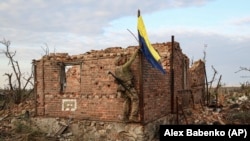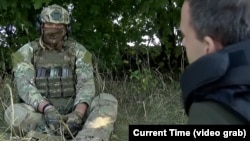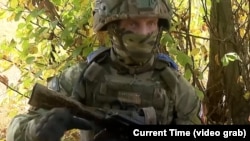Near KLISHCHIYIVKA, Ukraine -- After months of intense fighting to dislodge Russian units north and south of Bakhmut in eastern Ukraine, Kyiv’s forces recaptured the nearby tactically important village of Klishchiyivka in a move that Ukrainian officials say could set the stage for further military advances.
Located approximately 9 kilometers south of Bakhmut, Klishchiyivka -- which Ukrainian military officials said they recaptured on September 18 -- is part of a recent series of modest but potentially crucial gains for Kyiv as it searches for a major breakthrough in its grueling counteroffensive to wrest back territory from Moscow.
Speaking to Current Time, a Russian-language network run by RFE/RL in cooperation with VOA, members of the “Tsunami” regiment within an assault brigade of Ukraine’s National Guard, described chaotic and hard-fought battles to retake the village that has left much of the area razed to the ground, with damaged equipment and corpses still being recovered.
“After encountering war for the first time, you quickly rethink it,” said Dmytro, a former priest who signed up to the National Guard’s newly formed assault brigades six months ago and asked to be identified only by his first name. “You imagine it one way, but it looks completely different in reality. There’s nothing beautiful in combat operations. It’s chaos, screams, and explosions.”
Ukrainian commanders have described the capture of Klischiyivka and the recent retaking of nearby Andriyivka as stepping stones for taking back Bakhmut, which fell to the Russians after months of some of the war’s heaviest fighting. These small gains in the east -- along with similar ones across the south and southeast -- will allow Ukrainian forces to advance farther toward Russian positions in order to deliver more accurate artillery strikes, Ukrainian officials say, and help cut off road and railway access that is crucial for the Russian military’s logistics.
But the incremental progress also highlights the difficulties that Kyiv faces since launching its counteroffensive in June. Russia still has substantial defenses in place, including areas saturated with tank and antipersonnel mines, and Ukrainian forces have retreated and advanced again in recent months amid intense fighting that has ranged from artillery barrages to house-by-house street fights.
“It wasn’t easy, sometimes we wanted to give up,” said Valeriy, a soldier in the Tsunami regiment that helped capture Klischiyivka. “The worst thing is watching my guys get [wounded]. We kept having to retreat, regroup, pick up the wounded, and then prepare for an assault all over again.”
Counteroffensive Slogs Forward
The Russian Army has now withdrawn beyond Klischiyivka and Ukrainian forces have raised the country’s flag over the village.
Other members of the National Guard assault brigade who spoke to Current Time say that pushing back Russian troops came at a high cost, with many saying that it was reminiscent of the grueling battle for Bakhmut, which saw heavy losses on both the Russian and Ukrainian sides.
“Our group encountered the St. Petersburg riot police. There were 28 of them there, give or take, and they were dug in,” recalls “Prince,” a member of the assault brigade who asked to be identified by his military call sign. “We covered them with artillery strikes, but they stayed right until the end and kept shooting back. There were only six that made it out and retreated.”
Russian forces continue to periodically counterattack near Klischiyivka, but Ukrainian officials say they are well-positioned to keep pressing forward in the east, where analysts suggest Kyiv intends to keep Russian troops engaged as it searches for breakthroughs elsewhere in the country.
Grinding progress also looks to be moving forward in the southeast around the villages of Robotyne and Verbove along the line in Ukraine’s Zaporizhzhya region.
There, Ukrainian forces look to be pushing through Russia’s formidable defenses, which have become known as the Surovikin Lines -- named for the former head of Russian forces in Ukraine, General Sergei Surovikin, who was removed from his post earlier this year by Russian President Vladimir Putin.
The lines consist of three defensive layers of trenches and other defenses, with the final line made up of trenches and “dragon’s teeth” -- concrete pyramid-shaped obstacles intended to slow down vehicles and channel them into kill zones.
Unconfirmed videos and images posted online on September 20 appear to show Ukrainian Marder and Stryker infantry fighting vehicles advancing east toward Verbove, well past the first trench of Russian defenses.
Since then, new footage posted online has shown further advances, with analysts at the Washington-based Institute for the Study of War (ISW) stating in a September 24 update that geolocated photos and videos showed that "Ukrainian armored vehicles were operating slightly beyond Russian fighting positions near Verbove, indicating continued Ukrainian progress.”
The think tank added that while Ukrainian forces appear to have broken through some tri-layered Russian defenses in the area, in others, the fortifications passed by troops "are not the final defensive line” in Russia’s defensive depth in western Zaporizhzhya.
The report added that it is still unclear if Ukrainian forces are retaining these positions.
Digging In For A Long War
While the recent slate of small gains highlight incremental progress made on the battlefield by Ukrainian troops, the slow pace of the counteroffensive, which has the stated aim of driving Russian forces out of Ukraine entirely, has left some Ukrainian officials worrying about war fatigue in the West.
Governments in Poland, Estonia, Slovakia, and elsewhere in Central and Eastern Europe have been among Kyiv’s staunchest allies since the first day of Russia’s full-scale invasion, but many are facing upcoming elections or other domestic challenges that could see the level of their support waver.
Similar concerns remain over the United States as it prepares for presidential elections in 2024 with several leading Republicans being critical of continuing the same degree of U.S. support for Ukraine.
With potential obstacles looming, Kyiv is looking to keep Western arms flowing to its troops on the front line.
During a September 21 White House visit with U.S. President Joe Biden, Ukrainian President Volodymyr Zelenskiy was told that Washington would give Ukraine a version of the longer-range ATACMS ballistic missiles, without specifying how many or when they would be delivered.
General Mark Milley, the chairman of the U.S. Joint Chiefs of Staff, recently expressed caution about Kyiv being able to achieve its war goals -- both in the short-term and long-term.
“It’ll take a considerable length of time to militarily eject all 200,000 or plus Russian troops out of Russian-occupied Ukraine. That’s a very high bar. It’s going to take a long time to do it,” Milley said.
A similar sentiment was expressed by NATO Secretary General Jens Stoltenberg, who said that the war was likely to carry on for a longer period.
“Most wars last longer than expected when they first begin,” he told Germany’s Funke media group during an interview.














